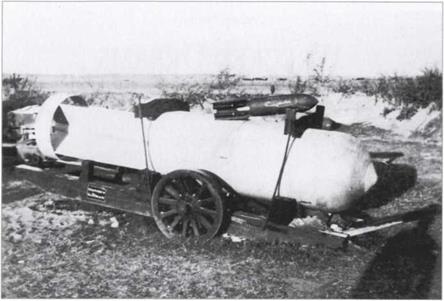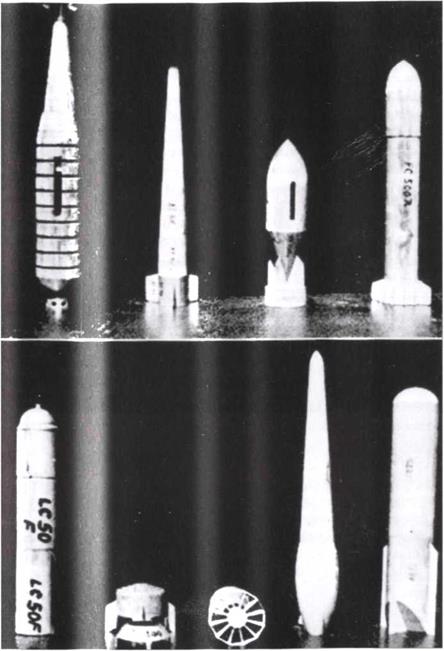Miracle Weapons
|
T |
he dream of the miracle weapon, the final twist in the Nazi Gotterdammerung, foresaw a dramatic turn away from total collapse to seize glorious victory in early 1945. Unstoppable offensive weapons such as guided bombs and missiles were to be created, and there was an arsenal of chemical and bacteriological bombs should they be required in retaliation.
Other than the Mistel attacks, fuel shortages meant that in 1945 bombing was limited on the German side to SD 500 bombs carried by the Ar 234 B-2 jet bomber, or disposable container loads under Fw 190 F-8s dropped to support embattled front-line troops. The new ultimate weapons were of a quite different nature, being the wishful thoughts of the Nazi leadership needing only to take on material form to turn defeat, at even ‘one minute past twelve’ as Hitler promised, into victory.
Large Bombs and Guided Missiles
Most bombs available to the Luftwaffe at the end of 1944 could fit into the roomy bomb-bays of the planned long-range carriers. Nearly all thin – and thick – cased explosive and shrapnel bombs from SC 50 to SC 1800 were in stock in Luftwaffe arsenals. From the end of 1942, heavier bombs capable of inflicting great damage were made, such as the SB 2500 A-l or SC 2500 B-l, but only about 100 were available. Even bigger was the SC 5000 which could not be series-produced for lack of capacity. This 5.2-metre long mine was intended to destroy city blocks and large industrial concerns. A few SA 4000 had been built, and a few tested, but as the air attacks on England died away, the SA 4000, SC 2500 and SC 5000 were all cancelled. The special hollow-charge SHL 6000 bomb designed for use against large warships, major bridges and extensive industrial installations carried a much larger charge than even the Ju 88 Misteln.
The largest conventional bombs ever planned in Germany were 10- to 30- tonners, designed for use from Dr Eugen Sanger’s rocket bomber, and which would have caused enormous damage when dropped from a height of 100 miles up. The largest would have blasted a crater 100 metres deep, or burrowed through
|
Very heavy bombs, such as the 2.5-tonne SB 5000 illustrated here, lost their significance from the autumn of 1944 when most of the Luftwaffe’s bomber units were disbanded. |
10 metres of reinforced concrete. These bombs had a design length of 11.2 metres and a diameter of 1.4 metres. The megabomb and a comparatively light 1-tonne model for dropping from great altitudes existed only on paper.
The various free-fall glider bombs, PD 1400X or the more powerful PD 2500X, were envisaged as remote-controlled weapons systems for the projected long-range bombers. Together with improved TV-guided Hs 293s and Hs 294s they were intended for pin-point targets. Great progress had been made towards remote-steering free-fall heavy bombs and air-launched rockets such as the BV 246, forerunners of the modern cruise missile. Although about 1,050 units were built between 1943 and 1945, only the short-range version entered service, on 15 August 1944. By then KdE crews had launched 119 BV 246s, but guidance problems limited their use to ground targets. Another 2,300 В V 246s were ordered in January 1945, these having automatic target-seeking equipment, although the OKL thought about having them as poison gas carriers should the need arise. Since most of these bombs were only of use at short ranges, and fuel for the carrier aircraft such as the He 111 or Ju 188 was short, the BV 246 saw litde action.
From January 1945, Hs 293 operations were almost non-existent since fuel that might have gone to carrier aircraft was more urgendy required for air defence of the Reich. At the beginning of 1945 the last KG 100 Gruppe, almost fully equipped for guided weapons operations at Aalborg in Denmark, abandoned its
|
|
|
by Allied electronic disruption. For this reason radio control was replaced by wire guidance. For operations over the Eastern Front the older Hs 293 A versions available in large numbers were used because the Red Army had no jamming equipment. Instead massed AA guns of all calibres defended important ground targets against air attack.
KG 200 alone was in a position until the end of April 1945 to launch the last glider-bomb attacks in reasonable numbers, mainly against the Oder bridges. All other bomber Gruppen were used in the transport role flying supplies to besieged cities and towns surrounded by the Red Army in the German hinterland which had become the Eastern Front.












